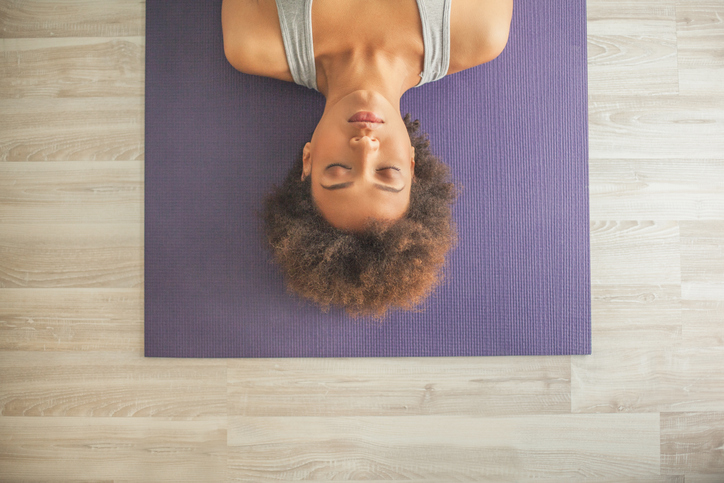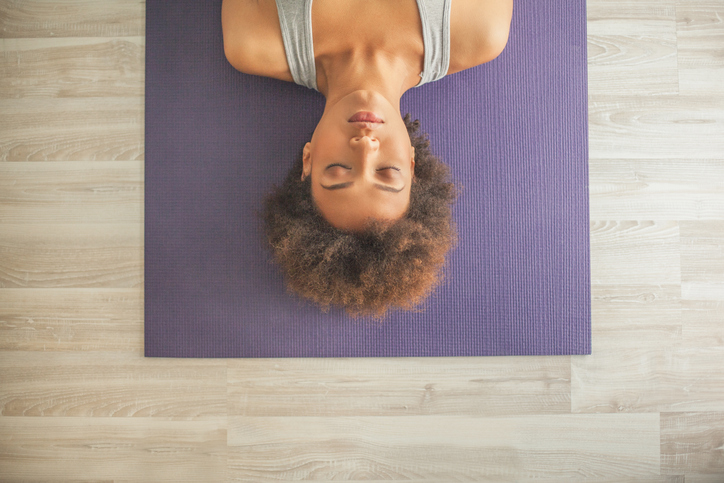
Ah, to get a restful nights sleep! For many of us, a full 8 hours of sleep is something we only dream about during whatever REM sleep we are able to get. A good night’s sleep is incredibly important for your health. In fact, it’s just as important as eating healthy and exercising. Unfortunately, many of our daily stresses are interfering with natural sleep patterns and causing our sleep to be interrupted and shortened. Here are a few yoga poses for better sleep.
Yoga Poses For Better Sleep
 If you are looking for a holistic and natural approach to bettering the quality of your sleep, yoga postures and breathing exercises might be the solution. Also, make sure to consult your doctor if you have questions or concerns about a yoga pose or a breathing exercise. Always enter a pose slowly to ensure there is no pain or tension. If something doesn’t feel right, listen to your intuition and back out of it.
If you are looking for a holistic and natural approach to bettering the quality of your sleep, yoga postures and breathing exercises might be the solution. Also, make sure to consult your doctor if you have questions or concerns about a yoga pose or a breathing exercise. Always enter a pose slowly to ensure there is no pain or tension. If something doesn’t feel right, listen to your intuition and back out of it.
1. Cat and Cow Pose
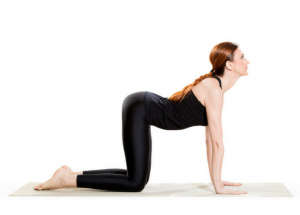
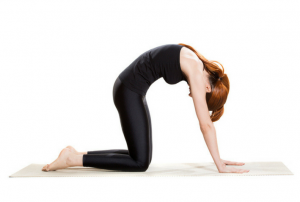 A great set of complementary poses that will release your spine and incorporate your breath. Start on your hands and knees. Inhale into Cow pose by bringing the crown of your head and tailbone up toward the ceiling, hollowing out your lower back. For cat pose, exhale as you tilt the crown of the head and tailbone down to the ground, arching your spine into a C-curve and pulling the shoulder blades apart. Flow between these two poses as long as you’d like, moving with the pattern of your inhales and exhales and feeling like you’re putting space between every vertebrae and loosening up your spine. To slow down and control your breath, try to match the length of each inhale and exhale with the length of each pose, with a momentary pause between cycles.
A great set of complementary poses that will release your spine and incorporate your breath. Start on your hands and knees. Inhale into Cow pose by bringing the crown of your head and tailbone up toward the ceiling, hollowing out your lower back. For cat pose, exhale as you tilt the crown of the head and tailbone down to the ground, arching your spine into a C-curve and pulling the shoulder blades apart. Flow between these two poses as long as you’d like, moving with the pattern of your inhales and exhales and feeling like you’re putting space between every vertebrae and loosening up your spine. To slow down and control your breath, try to match the length of each inhale and exhale with the length of each pose, with a momentary pause between cycles.
2. Child’s Pose
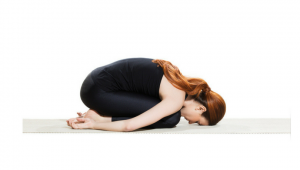 From hands and knees, sink your hips back to your heels and settle your chest between your thighs. Your big toes should touch one another and your knees are as far apart as they need to be in order to help you settle comfortably and be able to breathe deeply. With your forehead resting on the ground or a blanket, walk your fingertips out in front of you and stretch through the arms. You can also roll your forehead from side to side on the ground to give yourself a mini face massage.
From hands and knees, sink your hips back to your heels and settle your chest between your thighs. Your big toes should touch one another and your knees are as far apart as they need to be in order to help you settle comfortably and be able to breathe deeply. With your forehead resting on the ground or a blanket, walk your fingertips out in front of you and stretch through the arms. You can also roll your forehead from side to side on the ground to give yourself a mini face massage.
This is a great time to slow down your breathing and allow the exhales to soften your body down, releasing any tension in the shoulders and back.
3. Legs Up the Wall
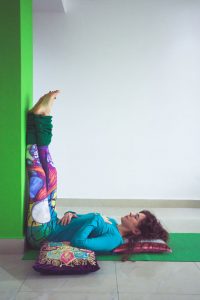 Transitioning onto your back, position yourself so your tailbone (lowest part of your back) is leaning against the base of a wall, or another flat, tall surface. The headboard of your bed might even work!
Transitioning onto your back, position yourself so your tailbone (lowest part of your back) is leaning against the base of a wall, or another flat, tall surface. The headboard of your bed might even work!
Extend your legs straight up the wall. If you can, bring your tailbone closer to the base of the wall, perhaps even to the point where your glutes and upper hamstrings are touching it. This pose can be a great gentle hamstring stretch if you can keep the legs straight.
This pose helps drain lymph and lactic acid from the legs, which helps prevent injury and decrease the symptoms of fatigue and soreness if you spend a lot of time on your feet. Allow the looseness that you brought into your back with the previous postures help you feel more comfortable in this pose. Place a pillow under your head for additional support and feel free to either place your hands on your chest and belly, or stretch them out to a ‘T’ shape.
4. Supine Spinal Twist
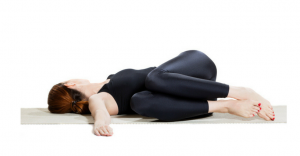 Transitioning away from the wall, bring both knees into your chest and rock side to side or take big circles with your knees. When you’re ready, bring your arms out into a ‘T’ with your hands in line with your shoulders and let your knees fall over to one side. You can keep both knees bent, straighten the top leg, or choose to straighten both legs. If you’re not feeling as much of the twist as you’d like, try to adjust your hips further over to the middle of your space so that your back is in one straight line —this may intensify the stretch in the lower back. If you’d like a neck stretch as well, turn your head to the side opposite your knees. After a few breaths, switch sides.
Transitioning away from the wall, bring both knees into your chest and rock side to side or take big circles with your knees. When you’re ready, bring your arms out into a ‘T’ with your hands in line with your shoulders and let your knees fall over to one side. You can keep both knees bent, straighten the top leg, or choose to straighten both legs. If you’re not feeling as much of the twist as you’d like, try to adjust your hips further over to the middle of your space so that your back is in one straight line —this may intensify the stretch in the lower back. If you’d like a neck stretch as well, turn your head to the side opposite your knees. After a few breaths, switch sides.
 When you’re ready to get in bed for the night, the right breathing exercises could be beneficial to relax your body, mind, and even help you doze off.
When you’re ready to get in bed for the night, the right breathing exercises could be beneficial to relax your body, mind, and even help you doze off.
Pranayama For Sleep
 Pranayama or breathwork is another great way to promote better z’s. Here are three simple breathwork practices you can try to help you sleep before bed.
Pranayama or breathwork is another great way to promote better z’s. Here are three simple breathwork practices you can try to help you sleep before bed.
1. Meditative Breath
For a short meditation, sit up in bed with your back straight and your head tucked slightly forward. Progressively begin to lengthen your breaths. For the first exhale, count to one. Then count to two, then three, all the way up to five. After your fifth exhale, held for a count of five, start over again at one. By keeping this pattern you allow your mind to remain focused on your breath instead of anything swirling through your mind in the evening.
2. Diaphragmatic Breath
With one hand on your lower belly and the other on your chest, take five deep breaths, inhaling for a count of three, then exhaling for a count of three. Clear your mind by focusing on the way your hands rise and fall according to your inhales and exhales.
3. Visualizing Breath
As you inhale, envision the air traveling into your nose, through your entire body, and back out again. Imagine it traveling through all your muscles, all the way to your toes and fingers, before it comes back out again during your exhale.
Focusing on your breathing activates your parasympathetic system, (also known as the rest and digest system) encouraging it to calm down, relax, and lower your heart rate in preparation for sleep.


